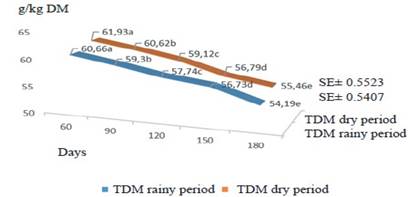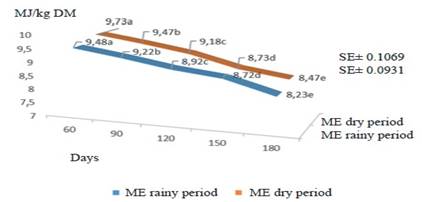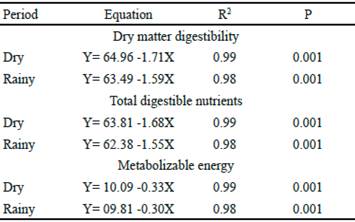Demographic predictions have shown a population increase during the last 20 years that lead to a worsening of food situation due to the low availability of nutrients, specially protein, and the non-equal distribution as a consequence of globalization (Jarquín et al. 2013). With the addition of energy scarcity and environmental contamination, it will not be promising the heritage of the future generations. With these antecedents, it will be necessary to face the world of tomorrow (Verdecia et al. 2014a).
In tropical countries like Cuba, with reduced grain and cereal productions, the search of feeding strategies for cattle with local and regional resources, and agroindustrial by-products, constitutes one of the main aspects of its cattle rearing system, and in the degree of independence and competitiveness it may reach (Peraza et al. 2015). Limited amounts and high prices of raw matters rich in energy and protein, as well as their competitive and efficient use, leave no other way for the future than to increase the efforts on local production of alternative feeding sources (Almeida 2015), so it assures the productive potential of animals in tropical areas (Bustamante et al. 2016).
Due to feeding deficit and global economic crisis, Latin American countries had to search for other feeding strategies to increase animal production in tropical areas through the supply of other protein and mineral sources to cattle, which generally are limited in conventional feeds and do not compete with human food (Díaz 2014 and Friedrich 2014).
In this sense, biomass of trees, shrubs and legumes have a leading role because of their considerable indicators of protein and acceptable nutritional value (Bustamante et al. 2015). Therefore, the objective of this study was to evaluate the effect of regrowth age on the bromatological composition of Moringa oleifera foliage in both seasons in the east of Cuba.
Materials and Methods
Research area, climate and soil. The study was developed in the farm La Victoria, located in the Consejo Popular Barranca of Bayamo municipality, Cuba, between 2013 and 2014. Two seasons were considered: rainy (May-October) and dry (November-April).
During the rainy period, rains were 731.4 mm. Mean, minimum and maximum temperature registered values of 26.73, 22.31 and 33.92 ºC, respectively and relative humidity was 80.78, 51.02 and 96.22 %, for mean, minimum and maximum, respectively. In the dry period, precipitations reached values of 270 mm, temperature was 24.05, 18.29 and 31.58 ºC for mean, minimum and maximum, respectively, and minimum, mean and maximum relative humidity with values of 76.21, 44.16 and 97.03 %, respectively.
The soil of the area was red ferrallitic (Hernández et al. 1999), with pH of 5.2. Content of P2O5, K2O and total N was 2.2, 31.39 and 3 (mg/100g of soil), respectively with 2.8 % of organic matter (Dirección Provincial de Suelos y Fertilizantes de Granma 2007).
Treatment and experimental design. A random block design was used with four replications and treatments were regrowth ages of 60, 90, 120, 150 and 180 days.
Proceedings. After the establishment period, areas had a 98 % of moringa. At the beginning of each season, a homogeneity cut was performed at 1 m over the soil level. From that moment, samplings were carried out according to treatments in 10 random plants in each plot of 5000 m2, removing the border effect. Samples were manually separated in leaves, petioles and stems with a diameter lower than 2 cm.
Determination of chemical composition. Dry matter (DM), crude protein (CP), ashes, organic matter (OM), P, Ca, and Mg, according to AOAC (2000), and NDF, ADF, LAD, cellulose (Cel), hemicellulose (Hcel) and cellular content (CC) according Goering and Van Soest (1970). Dry matter digestibility was quantified through Aumont et al. (1995). Metabolizable energy was established regarding Cáceres and González (2000) and total digestible nutrients according the stated by Martín (1998). All the analysis was conducted by duplicate and by replication.
Statistical analysis and calculation. The analysis of variance was performed according to the experimental design and also linear regression between some indicators and regrowth age (Balzarini et al. 2010) and mean values were compared through multiple range test of Duncan (1955). For normal distribution of data, Kolmogorov-Smirnov (Massey 1951) test was used and Bartlett (1937) test was used for variance.
Results
Related to chemical composition during rainy period (table 1), DM, NDF, ADF, LAD, Cel, Hcel, CC, Ca, Mg and ash were increased with age, with values of 8.26, 18.62, 17.81, 12.98, 17.10, 11.82, 0.87, 0.10 and 12.61 percentile units, respectively. CP, CC and OM decreased in 8.99, 18.62 and 3.85 percentile unit, respectively. There were significant differences (P<0.05) among the studied ages for each of the indicators, except for phosphorus.
Table 1 Chemical composition Moringa oleifera foliage during rainy period.

abcde Different letters in the same line differ for P<0.05 (Duncan 1955)
In dry period (table 2), there was a similar performance to that registered during rainy period, with increase of DM, NDF, ADF, LAD, Cel, Hcel and ash of 8.06, 18.96, 19.3, 12.62, 17.38, 11.02 and 10.34 percentile units, respectively. CP, CC and OM decreased in 8.92, 18.96 and 12.47 percentile units, respectively. Minerals (Ca, P and Mg) maintained a variable performance, although there was a tendency to increase with age.
Table 2 Chemical composition Moringa oleifera foliage during dry period

abcde Different letters in the same line differ for p<0.05 (Duncan 1955)
In both seasons, dry matter digestibility decreased (P<0.05) with the increase of age, being 6.62 and 6.61 percentile units in rainy and dry period, respectively (figure 1).
Total digestible nutrients and metabolizable energy of Moringa oleifera foliage decreased (P<0.001) with regrowth age in both seasons, with a decrease of 6.47 and 6.48 g/kg DM and 1.25 and 1.26 MJ/kg DM of metabolizable energy for dry and rainy periods, respectively (figures 2 and 3).
Table 3 shows equations of linear regression among dry matter digestibility, total digestible nutrients and metabolizable energy, and regrowth age in both seasons. In all cases, the slope was negative and determination coefficient was high with high precision (P<0.001).
Discussion
Deterioration of cattle rearing needs profound transformations for its exploitation, based on agro- ecological concepts, where production systems are considered as an ecosystem and not as a simple technical and economic issue, so as its participants (plants, animals, soil, climate, humans and technologies) are synchronically bonded and allow its effective, efficient and productive use with positive economic, social and environmental results. This new vision requires the knowledge of laws that control the functioning of each element and processes of the system, with the objective of maximizing the energy flow and material recycling (Verdecia et al. 2014b and Velázquez-Zavala et al. 2016).
This principle was the base for the study of Moringa oleifera, which could be useful for feeding systems in Granma province, mainly because there is not enough information on its performance under the specific conditions of this region. Its leaves are eagerly consumed by any kind of animals like ruminants, camels, pigs, birds, even carps, tilapias and other herbivorous fish. Therefore, it is considered as one of the most complete forages, rich in protein, vitamin and minerals, and excellent palatability (Gutiérrez et al. 2015).
Dry matter increased with regrowth age due to, among other aspects, maturity degree of the plant and, consequently, the increase of its structural components. Several studies showed dry matter values of 19.1 %, similar to those found in this study at 60 days of age by Rodríguez et al. (2014), although the environmental conditions were different, which demonstrates a good adaptation of this species to different climate conditions (Verdecia et al. 2014b). Studies of Ríos (1999) showed values of dry matter similar to those found in this research at 180 days, although climate conditions were different (with temperatures of 26 ºC and precipitations of 1400 mm).
Protein decreased with regrowth age and this could be related to the reduction of protein compound synthesis, to the decrease of leaf amounts, to the increase of stem fraction and to the increase structural carbohydrate synthesis (cellulose and hemicellulose), and it is important to highlight that values, in both periods, surpass 14 %. High content of CP, fragility of the cell wall of this species, especially at early ages, provide greater digestibility of dry matter and nitrogen (Pedraza et al. 2013).
CP concentration in the present study is in the range of values reported by Norton et al. (2000), García et al. (2009), Pinto-Ruíz et al. (2010), Rodríguez et al. (2014), Aye and Adegun (2013) and Caro et al. (2013) in Moringa oleifera, Leucaena leucocephala, Trichantera gigantea, Tithonia diversifolia and Gliricidia sepium.
These results coincide with the values observed in other studies on shrubs (Aye and Adegun 2013). However, it is important to consider that there is a wide variation of CP values reported in the literature, probably due to the effect of parts of collected plants, their phenological stage, season in which they were collected, frequency of cuts, management, climate and soil where the plants were developed, on the results (Edwards et al. 2012).
On the other hand, it would be important, not only to know the content of CP since it is obtained from the product of total nitrogen determination by the 6.25 factor, but it is necessary to know the fractioning of this nitrogen by determining other nitrogenous forms such as NO2 and NO3, among others, for the function they can perform in the nutrition of ruminant and monogastric animals.
The increase of the cell wall with age could be related to the physiological and anatomical changes that occur when the plant ages, which causes the decrease in the proportion of cytoplasmic content. Cellular lumen is reduced with its soluble components and the fibrous compounds are increased (Herrera and Ramos 2015). This is much more accentuated as yield increases, due to the water balance of the plant and the amount of nitrogen available in the soil, among other factors.
The values of fiber fraction components are related to the particularities of each species and the formation of the secondary structure of the cell wall of legumes. Both aspects are determined by genetic and environmental control (García et al. 2013).
This species showed variability in the mineral content. These results agree with those reported by Pérez et al. (2013) in Gliricidia sepium, Tithonia diversifolia, Leucaena leucocephala and Epiphyllum hookeri with values of Ca and P in the ranges of 1.45-2.8 % and 0.11 - 0.19 %, respectively. However, P tenors found in the present research are superior to those of these authors, because the experimental conditions were different, aspects that influence on the assimilation and distribution of nutrients in the different parts of the plants.
This performance is caused by the specific requirements of each species for the functioning of its metabolism, which is closely related to cropping conditions and the ability of plants to selectively adsorb certain cations present in the soil, as well as their availability (Verdecia 2015 and Herrera et al. 2017).
Mg indicators reported in the present research are inferior to those found by Juárez et al. (2013) in M. alba (0.47 %) and coincide with that reported in evaluations of tropical forages, trees, shrubs and legumes that serve to feed ruminants (Llanes et al. 2016). The reasons for these differences were previously explained.
Concentrations of ash are higher than those reported by Guzmán et al. (2015) in several species of the genera Abizia, Cassia, Pithecellobium and Moringa, who found values from 5 to 9 %. On the other hand, ash can be considered as an important indicator when providing an idea about the capacity of mineral absorption of the soil, as well as its content in the plant.
Although the OM content in this research was 84 %, it is considered high and coincides with that indicated by Bugarín et al. (2009) in L. glauca and C. ternatea, while Rodríguez et al. (2014) obtained superior results in Moringa oleifera with 90 %.
On the other hand, Ramírez et al. (2002) stated that, depending on the type of tissue, as plant cell matures, the cell wall widens and, commonly, produces a secondary wall of different composition, with remarkable deposition of aromatic constituents, so that chemical and anatomical changes occur. This may correspond to the results obtained in the present research related to fiber fractions and their components.
The results of DM digestibility obtained in this research are superior to those achieved by Soto et al. (2009) in T. diversifolia at 70 and 140 days of regrowth with 57 and 48%, respectively. The difference could be attributed to the best leaf-stem ratio and the lowest lignin concentration in the stems. However, taking into account that digestibility of forages is influenced by a group of factors such as the characteristics of food and of animals, among others, it is important to elucidate the particularities of each species to rationally use the biomass they provide.
Tropical grasses in the growth first stages show a thin cell wall, with little fiber, that allows an easy rupture of the fiber structures and short times of digestion. When regrowth age of plants increases, vascular structures of leaves become thicker, as do the vascular tissue and the sclerenchyma. Both, leaves and stems, become gradually lignified and physically stronger and difficult to reduce in size, which could be different in shrub species (Medina et al. 2009).
Similar explanation could be valid for the total digestible nutrients and metabolizable energy. However, there are two known constituent groups in plants, which are cell content and cell wall. The first constitute of sugars, organic acids, nitrogenous substances and lipids, whose digestibility in ruminants is total (carbohydrates) or almost total (proteins and lipids). The second group is composed of polysaccharides, cellulose, hemicellulose and pectic substances that have variable digestibility (40-90%) and of lignin that is considered totally indigestible. Therefore, the final value of digestibility, total digestible nutrients and energy will depend on the balance of these two groups (Herrera 2008 and del Pozo et al. 2011). It should be added the influence of plant management, climate and the type of soil where it develops.
Linear regression equations among digestibility, energy and total digestible nutrients indicated the marked effect of regrowth age in this plant to present high coefficients of determination with high precision. In addition, the little variability of coefficients of expressions in both seasons was significant, as well as the similarity among slopes. This could indicate the favorable response of this plant to low rainfall during dry season and a priori be considered a plant with a certain tolerance to drought.
Conclusions
In Moringa oleifera, managed without irrigation or fertilization and with low values of precipitation, especially in the dry season, it was evident that as regrowth age of the plant increases, its nutritional quality is reduced, mainly by the increase of NDF, ADF and LAD, and decrease of CP, DMD, energy and TDN, among other aspects. It is suggested to study lower regrowth ages, as well as biomass yields, secondary metabolites and their possible tolerance to drought.











 text in
text in 






